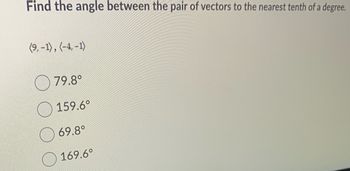
Calculus: Early Transcendentals
8th Edition
ISBN: 9781285741550
Author: James Stewart
Publisher: Cengage Learning
expand_more
expand_more
format_list_bulleted
Question

Transcribed Image Text:Find the angle between the pair of vectors to the nearest tenth of a degree.
(9,-1), (-4,-1)
79.8°
159.6°
69.8°
169.6°
Expert Solution
This question has been solved!
Explore an expertly crafted, step-by-step solution for a thorough understanding of key concepts.
Step by stepSolved in 2 steps with 2 images

Knowledge Booster
Similar questions
- Find v-u. v=4i-7j and u= - 9i + 2j O A. O B. - 50 00 -5i-5j 0 O D.-22 с. - 36i - 14jarrow_forwardStep 5 Take arccos of both sides of the equation to find the angle between the vectors u and v in radians. √2 4 (1-√3) arccos (√² (1-√3)) cos 8 = 8 11arrow_forwardFind the angle between the given vectors to the nearest tenth of a degree.u = <2, -4>, v = <3, -8>arrow_forward
- upuates Reduy Some apps currently in use are preventing automatic updates. Two 30-pound forces are acting on an object in the plane. If the angle between the forces is 30 degrees, find the resultant to the nearest pound of the two forces.arrow_forwardAdd & subtract vectors in magnitude and direction.arrow_forwardConvert to rectangular 22 – 120° o None of these -V3+ i -1+iy3 -V3 – i -1 - iv3arrow_forward
- Please show all stepsarrow_forwardA plane is flying with an airspeed of 140 miles per hour and heading of 155∘degrees. The wind currents are running at 40 miles per hour at 175∘degrees clockwise from due north. Use vectors to find the true course and ground speed of the plane. Round to the nearest whole number. true course - ground speed -arrow_forwardFind the angle theta between the given vectors to the nearest tenth of a degree. You must show work on a separate sheet of paper to rebeive credit. U=12i+7j V=-4i+5jarrow_forward
- Use the component method to add the vectors A and B shown in the figure. The length of B is 2.55 m and the angle e = 25.0°. Express the resultant A + B in unit-vector notation. A + B = 3.00 marrow_forwardSolve applications involving vectors. An airplane is flying on a compass heading (bearing) of 330° at 345 mph. A wind is blowing with the bearing 310° at 50 mph. (a) Find the component form of the velocity of the airplane. (b) Find the actual ground speed and direction of the plane.arrow_forward
arrow_back_ios
arrow_forward_ios
Recommended textbooks for you
 Calculus: Early TranscendentalsCalculusISBN:9781285741550Author:James StewartPublisher:Cengage Learning
Calculus: Early TranscendentalsCalculusISBN:9781285741550Author:James StewartPublisher:Cengage Learning Thomas' Calculus (14th Edition)CalculusISBN:9780134438986Author:Joel R. Hass, Christopher E. Heil, Maurice D. WeirPublisher:PEARSON
Thomas' Calculus (14th Edition)CalculusISBN:9780134438986Author:Joel R. Hass, Christopher E. Heil, Maurice D. WeirPublisher:PEARSON Calculus: Early Transcendentals (3rd Edition)CalculusISBN:9780134763644Author:William L. Briggs, Lyle Cochran, Bernard Gillett, Eric SchulzPublisher:PEARSON
Calculus: Early Transcendentals (3rd Edition)CalculusISBN:9780134763644Author:William L. Briggs, Lyle Cochran, Bernard Gillett, Eric SchulzPublisher:PEARSON Calculus: Early TranscendentalsCalculusISBN:9781319050740Author:Jon Rogawski, Colin Adams, Robert FranzosaPublisher:W. H. Freeman
Calculus: Early TranscendentalsCalculusISBN:9781319050740Author:Jon Rogawski, Colin Adams, Robert FranzosaPublisher:W. H. Freeman
 Calculus: Early Transcendental FunctionsCalculusISBN:9781337552516Author:Ron Larson, Bruce H. EdwardsPublisher:Cengage Learning
Calculus: Early Transcendental FunctionsCalculusISBN:9781337552516Author:Ron Larson, Bruce H. EdwardsPublisher:Cengage Learning

Calculus: Early Transcendentals
Calculus
ISBN:9781285741550
Author:James Stewart
Publisher:Cengage Learning

Thomas' Calculus (14th Edition)
Calculus
ISBN:9780134438986
Author:Joel R. Hass, Christopher E. Heil, Maurice D. Weir
Publisher:PEARSON

Calculus: Early Transcendentals (3rd Edition)
Calculus
ISBN:9780134763644
Author:William L. Briggs, Lyle Cochran, Bernard Gillett, Eric Schulz
Publisher:PEARSON

Calculus: Early Transcendentals
Calculus
ISBN:9781319050740
Author:Jon Rogawski, Colin Adams, Robert Franzosa
Publisher:W. H. Freeman


Calculus: Early Transcendental Functions
Calculus
ISBN:9781337552516
Author:Ron Larson, Bruce H. Edwards
Publisher:Cengage Learning